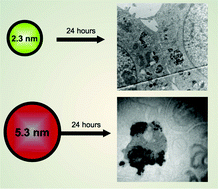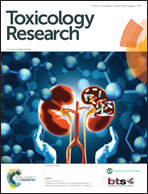The effect of “Jelly” CdTe QD uptake on RAW264.7 monocytes: immune responses and cell fate study†
Abstract
Encapsulation of Quantum Dots (QDs) has become an essential factor which regulates particles cytotoxicity, as well as physical and chemical stability. Negatively charged cellular membranes have a great affinity to nanoparticles with surface molecules carrying positive charge, hence creating perfect conditions for fast and aggressive intracellular penetration. The preference for non-charged outer shells is topical in QD design and various applications. In the current paper we develop gelatination as a prominent coating approach to create neutrally passivated QDs with improved biocompatibility. We have revealed the trends in particle's uptake, accumulation, intracellular localisation and retaining time as well as RAW264.7 monocyte cell fate and immune responses. Also the difference in particle endocytosis kinetics and dynamics has been shown to depend on the QD core size. The intracellular QD content along with cell responses at the population level was quantified by flow cytometry.


 Please wait while we load your content...
Please wait while we load your content...